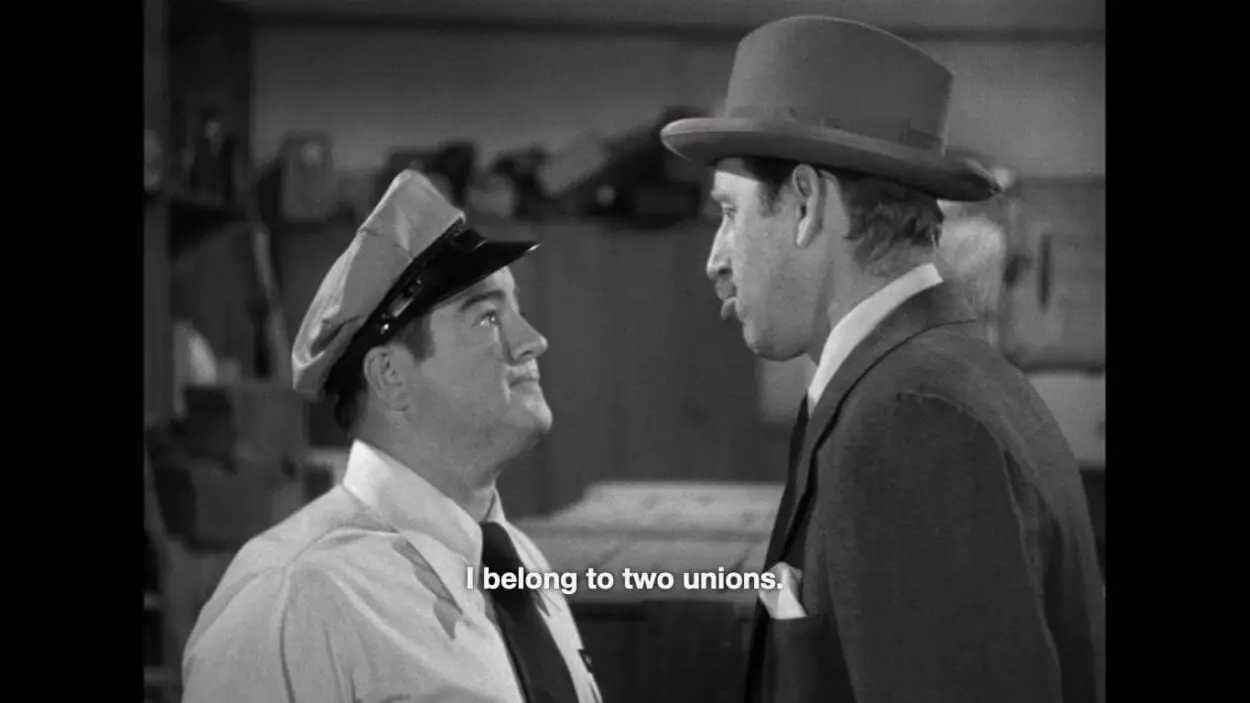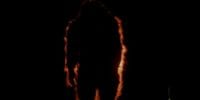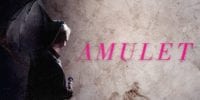Abbott and Costello Meet Frankenstein (1948) is a notable and significant entry in the horror comedy genre. It is not the first, the last, or even the most famous, but it is remembered, which is no small feat for a black-and-white film from 1948 starring a deceased comedy duo and monsters that, while more recognizable than ever over 70 years later, are arguably not the reliable audience draw that they were then.
Before we get started, Abbott and Costello Meet Frankenstein is available to stream for free (and legally!) on Peacock.

Horror and comedy, at face value, seem like genres that should mix like vampires and holy water, creating a steaming mess. Horror is already a misunderstood genre. I’ve lost count of how many times I’ve seen debates about whether a film fits under the label of monster movie, slasher, gothic horror, thriller, psychological horror, suspense, or any other designation.
Horror comedy is, perhaps, even more misunderstood. From people who think they’re too funny to be taken seriously, to people who think they’re too scary to qualify as comedies, to people who dissect them in an effort to define them as one or the other, horror comedies have a rough road on their way to appreciation.
These are films that can potentially hit every emotion. Depending on their intent and execution, horror comedies can make you laugh one minute, sweat the next, and even work your brain wondering what’s going to happen the next.
Horror comedy is a spectrum, and there are many ways to handle this combination of film flavors. Here, we’re going to look at how Abbott and Costello Meet Frankenstein combines the comedy with the creepy.
The Comedy
For those who aren’t already aware, Abbott and Costello were an existing and highly successful comedic duo of stage, radio, and film long before they met Frankenstein (-’s monster…and Dracula and the Wolf Man). Each filled a specific role in the duo.
The taller, thinner Bud Abbott was, generally, the “straight man.” The “straight man” (who can be played by a performer of any gender or orientation) is “the serious one.” They set up the joke. They are generally unfazed by all the chaos around them, though sometimes they can reach a breaking point and join in. If they get hit with a pie in the face, at best, they won’t be happy about it: at worst, they’ll explode in anger. The shorter Lou Costello was the opposite: “the wacky one.” They deliver the punchline. They make funny faces and weird noises. They avoid a banana peel only to trip on their own two feet. Together, you have a traditional “check and balance” of comedy.
Abbott and Costello bring this same dynamic to Chick Young and Wilbur Grey, respectively, in this film. Chick doesn’t believe in monsters, and certainly doesn’t believe his friend and colleague Wilbur when the latter freaks out after seeing Dracula and the Frankenstein monster. Nor does he believe Larry Talbot (a.k.a. The Wolf Man) when he shows up to warn Chick and Wilbur about Dracula and the Frankenstein monster.
Wilbur, on the other hand, believes wholeheartedly in the monsters before ever laying eyes on them, his fright manifesting in very physical and hilarious ways. When he does see them, his reactions are still comedic.
It’s the “You’ve got to believe me!” routine you’ve seen in so many horror movies (and to be fair, this film is early enough in film history for it not to have been as cliché as it would seem now), and yet, it feels fresh because the dialogue, staging, and characterization are so clever and the comedic timing is spot-on.
One of the reasons the humor works is because of how varied it is. There’s a lot of slapstick, to be sure, and Wilbur makes his requisite funny faces and noises (and even Chick gets to bug his eyes out and faint at one point), but there’s also a lot of clever plays-on-words and other spoken comedy that sometimes goes by so quickly, it’s easy to miss. (“Go look at yourself in the mirror sometime.” “Why should I hurt my own feelings?”)
The banter is so great, I find myself quoting it, even when no one else knows what I’m talking about. (I still wonder if someone wrote, “Oh, Chick!” into the script so many times knowing it sounds similar to another phrase that may be screamed in fright…)
There’s one exchange that floored me the first time I saw Abbott and Costello Meet Frankenstein that I long to quote one day…
Wilbur: “…I’m a union man. And I work only sixteen hours a day.”
McDougal: “A union man only works eight hours a day.”

Once we’re in the story proper, although we see Larry Talbot first, our first full introduction to this tale is through Chick and Wilbur. We can laugh at Chick and Wilbur’s misfortunes, and while Chick’s gruff and Wilbur’s not the brightest bulb in the House of Horrors, they’re decent people and they have a clear camaraderie with each other. Wilbur even has a girlfriend, Dr. Sandra Mornay (Lenore Aubert), who appears to care deeply for him; later, Wilbur defends Sandra when he tells Chick not to call her a “dame.” Even as we laugh at some of Wilbur’s foolishness, he still has that decency. By starting with these two characters before the monsters show up (give or take Sandra’s plan-in-motion), Abbott and Costello Meet Frankenstein ensures that we’re invested in whatever plot follows.

So…with these two good-hearted goofs as our protagonists, how does the horror factor in?
The Horror
“Count Dracula returns from beyond the grave, revives the Frankenstein monster, and blackmails a wanted doctor into helping him find a person whose brain can be put into the monster under his control to wreak havoc. Meanwhile, Larry Talbot (the Wolf Man) must help the innocent target while avoiding the full moon, and they all must foil the Count’s plan before it’s too late.”
While that sounds like an epic “monster mash” movie, it’s also the plot of Abbott and Costello Meet Frankenstein.
This is where the “horror” comes in: the monsters and their plot are taken seriously. If this plot happened to characters you’d see in a straight horror movie, it wouldn’t be funny. Neither the characters’ peril nor the threat and danger of the monsters themselves are compromised or dulled.
This is even shown in the casting of the monsters. Count Dracula is Béla Lugosi, reprising his role from Universal’s Dracula (1931) for the first and only time. Larry Talbot is Lon Chaney, Jr., who originated the role in The Wolf Man (1941) and played the lycanthropic Larry in every single Universal film in which the character appeared in that era. The Frankenstein monster is Glenn Strange, who had previously played the not-so-jolly green giant in House of Frankenstein (1944) and House of Dracula (1945). These casting choices show that the people behind this movie didn’t want comedians doing parodies of the famous monsters, but the actual monsters themselves.
The monsters are basically doing what they always do. Dracula’s using manipulation and hypnosis to claim victims and increase his power, this time also filling the role of the power-hungry villain who wants to use the Frankenstein monster for their own gain. Larry Talbot’s lamenting his lycanthropy and trying to do some good to counteract the carnage he causes in his lupine form, and the Wolf Man’s leaving destruction in his wake. And the Frankenstein monster’s throwing his weight, and others’ weight, around and causing chaos as he waits for a new brain.
So…with all these monsters already occupied with their own plot, how does comedy fit into their busy schedules?
How They Mix
From the beginning, the animated opening credit sequence helps set the tone: the exaggerated imagery showing both the comedic and macabre elements of the story to come.
The film’s serious-in-theory plotline is funny because it’s happening to Chick and Wilbur. Their reactions to the goings-on and their interactions with the monsters and each other make Abbott and Costello Meet Frankenstein as hilarious as it is, to the point where it bleeds over (pun intended) into the “horror side” of the plot, blurring the line between the horror and the comedy.
This is demonstrated well in a very early scene when Wilbur’s talking to Larry Talbot on the phone. If you watch just Larry’s side of the conversation, it’s a scene of a long-suffering man transforming into a werewolf underscored with intense orchestration and collateral damage to spare. If you just watch Wilbur’s side, it’s pure comedic confusion, until it devolves into barking like a dog in baffled frustration before hanging up with an unintentional pun. Together, they create a microcosm of how the horror and humor work in this film: alongside each other, with just enough crossover to make it exciting without taking away from either side.
Rather than the comedy cheapening the horror, in many ways, the comedic spice sharpens how the horror plot proceeds. Like many other horror comedies, Abbott and Costello Meet Frankenstein’s comedy, in some cases, makes the film smarter than some more traditional horror movies. One of the first things Wilbur does when he encounters Dracula is break the Count’s hypnosis when the latter’s back is turned and, upon seeing Dracula and the Frankenstein monster in the flesh, acts as though he’s still hypnotized. How many characters in more serious vampire movies can you recall who’ve done this?
Dracula gets in a few dark puns and plays-on-words. In a dead serious (no pun intended) horror movie, they might stick out in contrast to the rest of the movie. But with the comedic streak of this film, it falls into a nice sweet spot right between creepy and funny. Larry Talbot repeatedly roughly grabbing Costello’s lapels, in a straight horror movie, may come across as either dramatic or melodramatic, and Lon Chaney, Jr. plays it straight. But here, especially with Wilbur’s reactions, it’s funny every time. Wilbur hitting the Frankenstein monster and the Wolf Man before fully realizing who they are brings tense laughter, as well, as do his subsequent freak-outs.
I always highly recommend this film. Whether you know the Universal Monsters or not, whether you know Abbott and Costello or not, whether you’re familiar with “older” films or not: in fact, if you’re not familiar with any of these, it’ll be a delightful surprise. I’m happy to report that most of this film’s content has aged pretty well. Some of the verbal humor does have a sexist streak. I also think Sandra and Joan Raymond (Jane Randolph) are interesting characters that add to the film and that it’s a shame that they get sidelined in the last act.
Speaking of the last act, this is truly where the horror and comedy volley back and forth like vampires playing hot potato with a garlic clove. The monsters are relentless, fighting amongst themselves and going after Wilbur, Chick, and the rest of the gang. Wilbur and Chick are just as relentless throwing everything they can get their hands on in the moment back at the monsters. The combination makes for a very exciting and unpredictable climax…not to mention a literal last-minute cameo you’ll never see coming.

“I saw what I saw when I saw it,” and I saw Abbott and Costello Meet Frankenstein: a delightful blend of horror and comedy that stands as tall as the Frankenstein monster, even all these years later.



“Wilbur, on the other hand, believes wholeheartedly in the monsters before ever laying eyes on them” because Wilbur is a child and Chick is the adult.
“Wilbur, on the other hand, believes wholeheartedly in the monsters before ever laying eyes on them” because Wilbur is a child and Chick is the adult.